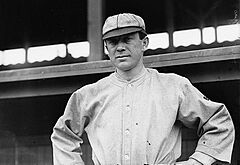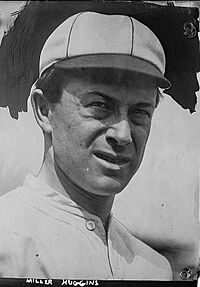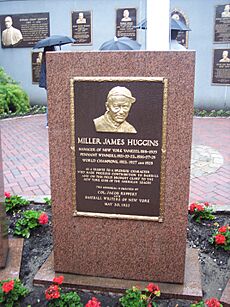Miller Huggins facts for kids
Quick facts for kids Miller Huggins |
|||
|---|---|---|---|

Huggins with the St. Louis Cardinals in 1910
|
|||
| Second baseman / Manager | |||
| Born: March 27, 1878 Cincinnati, Ohio, U.S. |
|||
| Died: September 25, 1929 (aged 51) New York City, New York, U.S. |
|||
|
|||
| debut | |||
| April 15, 1904, for the Cincinnati Reds | |||
| Last appearance | |||
| September 13, 1916, for the St. Louis Cardinals | |||
| MLB statistics | |||
| Batting average | .265 | ||
| Home runs | 9 | ||
| Runs batted in | 318 | ||
| Stolen bases | 324 | ||
| Managerial record | 1,413–1,134 | ||
| Winning % | .555 | ||
| Teams | |||
|
|||
| Career highlights and awards | |||
|
|||
| Induction | 1964 | ||
| Election Method | Veterans Committee | ||
Miller James Huggins (born March 27, 1878 – died September 25, 1929) was a famous American professional baseball player and manager. Huggins played second base for the Cincinnati Reds (1904–1909) and St. Louis Cardinals (1910–1916). He later became a manager for the Cardinals (1913–1917) and the New York Yankees (1918–1929).
He led the Yankees' amazing "Murderers' Row" teams in the 1920s. These teams won six American League (AL) championships and three World Series titles. Huggins was known for being smart and understanding the game very well. He was elected to the National Baseball Hall of Fame in 1964.
Contents
Early Life and Education
Miller James Huggins was born on March 27, 1878, in Cincinnati, Ohio. His father was from England and worked as a grocer. Miller had two brothers and one sister.
He went to Woodward High School and Walnut Hills High School in Cincinnati.
College Baseball Career
Huggins attended the University of Cincinnati. There, he studied law and played college baseball for the Cincinnati Bearcats baseball team. He was a shortstop and became the team captain in 1900.
Even though his father didn't want him to play baseball on Sundays, Huggins played semi-professional baseball. In 1898, he played for the Cincinnati Shamrocks using the name "Proctor." In 1900, he played for the Mountain Tourists and had a great .400 batting average.
After getting his law degree, Huggins realized he could earn more money playing baseball. One of his law professors, William Howard Taft, even told him to play baseball. Huggins was allowed to practice law, but he never did.
Playing Professional Baseball
Starting in the Minor Leagues
Huggins began his professional baseball journey in the minor league baseball in 1899. He played for the Mansfield Haymakers. From 1901 to 1903, he played for the St. Paul Saints.
He started as a right-handed hitter but began batting from the left side in 1902. This helped him improve his hitting. He also moved to second base while playing for St. Paul.
In 1902, Huggins had an amazing game with the Saints. He handled 19 plays at second base without making any errors. This set a new record for the time. In 1903, he made the first recorded delayed steal in baseball history.
Cincinnati Reds (1904–1909)
The Cincinnati Reds bought Huggins' contract in 1904. He made his first Major League Baseball (MLB) game on April 15, 1904. He was very good at getting on base.
In 1906, he had a .292 batting average and stole 41 bases. He also worked hard to make his upper body stronger. Huggins wanted to be the Reds' manager after 1907, but they chose someone else. In 1909, he had a tough year because of injuries.
St. Louis Cardinals (1910–1917)
Before the 1910 season, the Reds traded Huggins to the St. Louis Cardinals. On June 1, 1910, he set an MLB record. He had six chances to bat but didn't actually swing the bat once. He got four walks and two sacrifice flies. That year, he led the National League in walks.

In 1911, he tied a league record by making 16 successful plays in a game. He also finished sixth in the voting for the Most Valuable Player award. In 1912, he batted over .300 for the first time.
After the 1912 season, Huggins became the player-manager for the Cardinals. The team owner liked his polite manner. In 1914, the Cardinals played very well and almost won the league championship. It was their best finish since 1876.
Huggins helped young players like Rogers Hornsby improve their batting. Hornsby later took over as the team's second baseman in 1917. Huggins managed the Cardinals for one more year but then left the team.
Managing the New York Yankees
Building a Dynasty (1918–1929)
The New York Yankees were not playing well, and their owners wanted a new manager. The American League president suggested Huggins. One of the owners, Jacob Ruppert, was impressed by Huggins' baseball knowledge. Huggins signed a two-year contract to manage the Yankees.
When Huggins took over, he made many changes. He focused on teaching basic baseball skills, like how to bunt. He also made important player trades to improve the team.
In Huggins' first year (1918), the Yankees finished fourth. He continued to trade players to get better talent. He signed a new contract for $12,000 to stay with the Yankees.
The Yankees finished third in 1919 and 1920. In 1921, Huggins helped players like Aaron Ward and Wally Pipp get better. That year, the Yankees won their first American League championship! They reached the World Series for the first time but lost to the New York Giants.
Huggins kept working to improve the team's pitching. In 1922, the Yankees won the AL championship again but lost the World Series to the Giants once more. Despite the losses, the owners trusted Huggins, and he stayed as manager.
World Series Champions
In 1923, the Yankees finally won their first World Series title! They beat the Giants, who had won the previous two years. However, they didn't win in 1924, finishing second.
In 1925, the Yankees struggled. Huggins made big changes to the team's lineup. Most famously, he replaced Wally Pipp with Lou Gehrig at first base. This started Gehrig's amazing streak of playing in many games in a row.
Huggins also had to deal with star player Babe Ruth. Ruth sometimes didn't follow the rules. In August 1925, Huggins suspended Ruth and fined him $5,000 for not following team rules. Ruth thought the owner would take his side, but the owner supported Huggins. After apologizing, Ruth was allowed to play again and didn't challenge Huggins' authority after that.
Huggins rebuilt the team for the 1926 season. They won their fourth league championship but lost the 1926 World Series to the Cardinals.
In the 1927 season, Huggins' team was incredible. They won 110 regular season games, an American League record. They won the AL by 19 games! This team, known as "Murderers' Row," swept the Pittsburgh Pirates in the 1927 World Series. Many people think this was one of the greatest baseball teams ever.
Huggins' team won the AL championship again in 1928. They also swept the Cardinals in the 1928 World Series. This was the first time a team won back-to-back World Series by sweeping their opponents.
In 1929, the Yankees were not doing as well. Huggins started to feel sick in August 1929.
Death and Legacy

Miller Huggins became very ill on September 20, 1929. He went to the hospital with a serious infection and fever. Despite doctors' efforts, Huggins died on September 25, 1929, at age 51.
The American League canceled its games on September 27 for his funeral. Thousands of fans came to Yankee Stadium to pay their respects. He was buried in Spring Grove Cemetery in Cincinnati.
The Yankees found it hard to replace Huggins. Several people were offered the manager job, but they turned it down. Finally, Bob Shawkey became the manager for the 1930 season.
Playing and Managing Style
Huggins was small, standing 5 feet 5 inches tall and weighing 140 pounds. This earned him nicknames like "Mighty Mite" and "Rabbit." He was an excellent leadoff batter and a great defensive second baseman. He finished his playing career with a .265 batting average. He was good at getting walks and stealing bases. He stole 324 bases in his career.
As a manager, Huggins won 1413 games. He first focused on speed and small plays, but when superstar slugger Babe Ruth joined the team, he changed his strategy. He then built teams with powerful hitters and consistent pitchers.
Managerial Record
| Team | Year | Regular season | Postseason | |||||||
|---|---|---|---|---|---|---|---|---|---|---|
| Games | Won | Lost | Win % | Finish | Won | Lost | Win % | Result | ||
| STL | 1913 | 150 | 51 | 99 | .340 | 8th in NL | – | – | – | – |
| STL | 1914 | 153 | 81 | 72 | .529 | 3rd in NL | – | – | – | – |
| STL | 1915 | 153 | 71 | 82 | .464 | 6th in NL | – | – | – | – |
| STL | 1916 | 153 | 60 | 93 | .392 | 7th in NL | – | – | – | – |
| STL | 1917 | 152 | 82 | 70 | .539 | 3rd in NL | – | – | – | – |
| STL total | 761 | 346 | 415 | .455 | 0 | 0 | – | |||
| NYY | 1918 | 123 | 60 | 63 | .488 | 4th in AL | – | – | – | – |
| NYY | 1919 | 139 | 80 | 59 | .576 | 3rd in AL | – | – | – | – |
| NYY | 1920 | 154 | 95 | 59 | .617 | 3rd in AL | – | – | – | – |
| NYY | 1921 | 153 | 98 | 55 | .641 | 1st in AL | 3 | 5 | .375 | Lost World Series (NYG) |
| NYY | 1922 | 154 | 94 | 60 | .610 | 1st in AL | 0 | 4 | .000 | Lost World Series (NYG) |
| NYY | 1923 | 152 | 98 | 54 | .645 | 1st in AL | 4 | 2 | .667 | Won World Series (NYG) |
| NYY | 1924 | 152 | 89 | 63 | .586 | 2nd in AL | – | – | – | – |
| NYY | 1925 | 154 | 69 | 85 | .448 | 7th in AL | – | – | – | – |
| NYY | 1926 | 154 | 91 | 63 | .591 | 1st in AL | 3 | 4 | .429 | Lost World Series (STL) |
| NYY | 1927 | 154 | 110 | 44 | .714 | 1st in AL | 4 | 0 | 1.000 | Won World Series (PIT) |
| NYY | 1928 | 154 | 101 | 53 | .656 | 1st in AL | 4 | 0 | 1.000 | Won World Series (STL) |
| NYY | 1929 | 143 | 82 | 61 | .573 | illness | – | – | – | – |
| NYY total | 1786 | 1067 | 719 | .597 | 18 | 15 | .545 | |||
| Total | 2543 | 1413 | 1134 | .555 | 18 | 15 | .545 | |||
Honors and Recognition
In 1915, baseball writer Billy Evans called Huggins one of the best second basemen. He later said Huggins was "one of the greatest managers I have ever met."
The Yankees honored Huggins on May 30, 1932, by placing a monument for him at Yankee Stadium. He was the first Yankees legend to receive this honor. Later, monuments for Lou Gehrig and Babe Ruth were added. These monuments are now in "Monument Park" behind the centerfield fence.
Huggins' monument says he was "A splendid character who made priceless contributions to baseball." The Yankees also named a field after him in Florida, where they train in the spring.
Huggins was voted into the National Baseball Hall of Fame in February 1964. He was inducted that summer, after his death.
Personal Life
Huggins was a private person. He spent winters in Cincinnati when he played for the Reds and Cardinals. Later, he made St. Petersburg, Florida, his winter home while managing the Yankees. Huggins never married.
He enjoyed playing golf and billiards in his free time.
Huggins has been shown in several movies about baseball. Actors like Ernie Adams and Bruce Weitz have played him.
See also
- List of Major League Baseball career stolen bases leaders
- List of Major League Baseball managers by wins
- List of Major League Baseball player-managers



